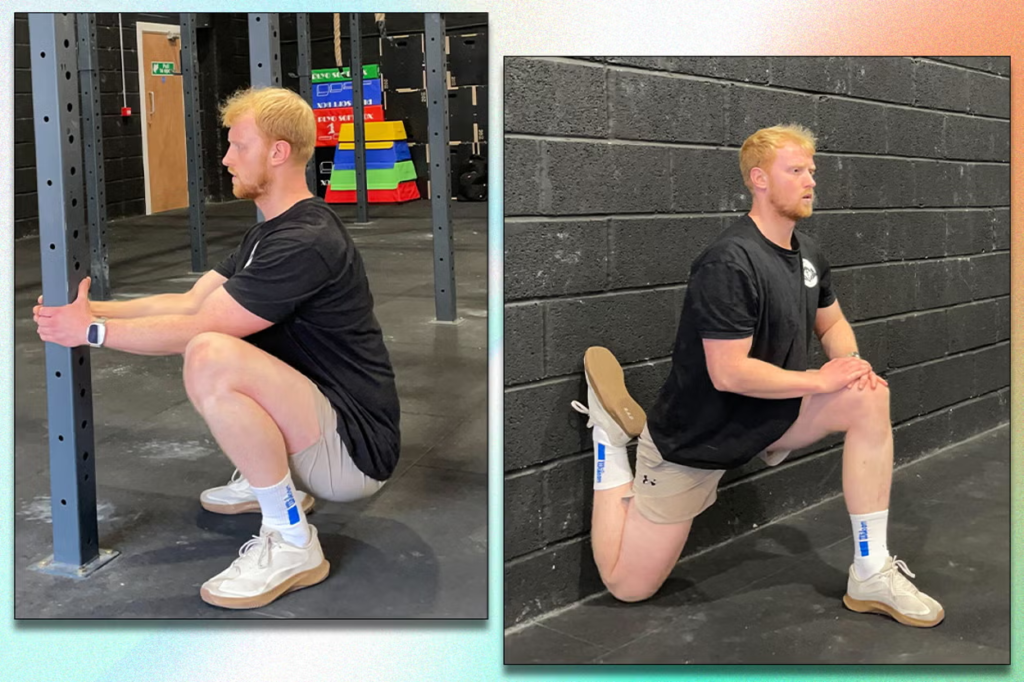Soothe sore muscles and ease tight hips with this seven-minute stretching routine

The five stretches you should do every day, according to a flexibility expert (The Independent),
You don’t have to commit to a strenuous HIIT session or a lengthy run if you’re looking to include some uplifting movement into your day but can’t always squeeze in a complete exercise. An excellent substitute is stretching, which relieves tense muscles and provides a much-needed respite from the pressures of a hectic schedule. It is easy to use, affordable, and advantageous to all.
Read more:https://otcnewsmagazine.com/five-stretches-you-should-be-doing-every-day-according-to-a-flexibility-expert/
Not sure where to start? Try this seven-minute routine from Tom Merrick, the Bodyweight Warrior, a renowned flexibility specialist with one million YouTube subscribers.
“The ability to move freely and without feeling restricted is what most people find most beneficial about becoming more flexible, even for simple tasks like playing with the kids or bending down to pick up something,” states Merrick.
Merrick has given five stretches that he thinks everyone should do every day to help release tight hips, improve shoulder health, and increase hip, knee, and ankle flexibility.
The five https://healthtipsbyimranqadir.blogspot.com/2024/09/five-stretches-you-should-be-doing.htmlstretches you should be doing every day
“The 90/90 stretch is one of my favorite overall stretches for the hips,” states Merrick. “It targets every angle you’ll need, working both the internal and external rotation of the hip joint, while promoting more movement and awareness in the hips.”
He says a lot of the folks he deals with have “a lot of tightness around the hips,” which frequently leads to the back doing more of the movement to make up for it.
Merrick also notes that extended sitting can cause the glutes to become compressed and tight, which might interfere with squats and other lower body exercises. “By increasing hip mobility, I’ve found it to be one of the best ways to help people feel more free and improve their movement,” he says.

How to do it
With your left thigh out in front of you and your right thigh positioned perpendicular to your chest, sit up straight. You can rest your hands on the ground behind you for support, and both of your knees should be at a right angle.
From here, raise both knees to the ceiling and then lower them so that your right thigh extends in front of you and your left leg becomes perpendicular to your torso.
For 90 to two minutes, alternate between these two postures, holding each for a few deep breaths.
Merrick shows how to improve this stretch or concentrate on particular muscles and motions in the video up above.
2. The couch stretch
This stretch works the quadriceps at the front of your leg and the hip flexors, which are the muscles surrounding your pelvis that assist in raising your knees toward your chest.
According to Merrick, engaging in physical activity such as running, cycling, or prolonged sitting can result in stiffness in the quadriceps and hip flexors.
The nature of these exercises encourages the hips to be stretched forward and tense. The sofa stretch provides the opposite effect of what you usually do throughout the day by extending your body, which helps offset that.
It’s also an excellent hip stretch because it doesn’t require bending the knee, which helps stretch the quadriceps muscle’s rectus femoris.

Fitness writer Harry Bullmore doing the couch stretch (The Independent / Harry Bullmore)
How to do it
Place your left knee on the floor against a wall, with your shin extending vertically upward. Step your right foot forward into a lunge position, ensuring your left thigh and torso form a straight line. Engage your glutes by tucking your hips, and try to pull your rear knee forward to activate the hip flexors.
For support, place your hands on the floor inside your right foot, directly beneath your shoulders. Hold this position for 60 to 90 seconds on each side.
To deepen the stretch, you can raise your torso to a more upright position. Merrick explains that the couch stretch can be adapted for various fitness levels. Beginners can keep their hands on the floor and lean forward over the front leg, while those with more flexibility can sit more upright to increase the stretch in the hips and quads.More flexible people can sit up straighter to improve hip and quadriceps elasticity.
3. The squat
Although this may seem more like a strength training workout than a stretching activity, Merrick notes that maintaining a firm squat stance demonstrates good flexibility in the knees, hips, and ankles, among other joints.
Being able to participate in this movement is crucial because it’s fundamental to human mobility, says Merrick. Being able to go into this low position is quite helpful, whether you’re playing with kids, lifting something up off the ground, or engaging in weight training, which frequently involves squats.

Fitness writer Harry Bullmore holding a squat position (The Independent / Harry Bullmore)
How to do it
Place your toes slightly outward and place your feet hip-width apart. As you lower your hips into a deep squat position, maintain an upright posture with your spine straight.
In order to provide additional support throughout the bottom of the squat, employ a firm anchor point in front of you if you have trouble staying balanced or keeping your spine straight and chest raised. Hold the squat for 60 to 120 seconds, or for more variations, see Merrick’s video.
According to Merrick, many people have a tendency to trip over when performing a deep squat. This frequently occurs as a result of restricted hip or ankle mobility, which rounds the spine and shifts weight to the back.
In order to address this, Merrick advises using the holding onto an anchor point, performing a deep squat, paying close attention to your technique, and keeping your chest raised.
According to Merrick, “this adheres to the SAID principle (specific adaptation to imposed demand).” Practice more if you want to get better at something. To obtain a nice stretch, choose a comfortable squat position and move around for a while.
Read more: An expert coach explains why squats should be a staple of your fitness regimen.https://otcnewsmagazine.com/five-stretches-you-should-be-doing-every-day/
4. The hang
Merrick claims that the hang is an adaptable exercise, much like the squat. It helps decompress the spine, extends the muscles surrounding the shoulder joint, such as the pectorals in the chest and the latissimus dorsi in the back, and improves overhead flexibility for better shoulder health.
“Standing, moving, and sitting throughout the day can cause compression in our spine,” Merrick says. Hanging allows gravity to extend and draw the spine lower.

Fitness writer Harry Bullmore in a dead hang position (The Independent / Harry Bullmore)
How to do it
With an overhand hold and a distance between your hands equal to your shoulder width, grab a pull-up bar. Raise your feet off the ground and let your body weight be supported by your hold. To keep your posture straighter, concentrate on drawing in your chest. Delay moving for a duration of 30 to 60 seconds.
If it is difficult for you to sustain your entire body weight, use a lower pull-up bar and maintain your feet on the ground to assist with some of the weight. As you gain strength, gradually lessen the help from your feet.
This hanging workout strengthens your grip while also correcting your posture. A study that was published in the journal Clinical Interventions in Aging underlined the importance of grip strength as a significant health indicator, especially for older persons. It is connected to total strength, bone density, and other critical health indicators.
“We are aware that grip strength is important for longevity as well as sports,” explains Merrick. “Practicing hanging will help you build up your grip naturally, and for most people, holding for 30 to 60 seconds is a good goal.”
5. The elephant walk into pike hold
The big muscles in the back of the thigh are called the hamstrings. Merrick, who has a great deal of experience assisting people in becoming more flexible, claims that one of the main things preventing clients from moving as freely as possible is tight hamstrings.
The hamstrings are nearly as important as a key when it comes to working on more advanced flexibility. Your hips may tilt and move more easily when you loosen them, which increases your total flexibility—especially when squatting and other similar activities. Thus, any type of hamstring stretching is really helpful.”
Merrick’s favorite workout for this is the elephant walk. To stretch your hamstrings while adjusting your hips, perform this technique by reaching towards the ground and then straightening each leg alternately.

Fitness writer Harry Bullmore doing the elephant walk stretch (The Independent / Harry Bullmore)
How to do it
Reach your hands toward the ground in front of you while maintaining an erect stance and a slight bend in your knees. With your right knee slightly bent, maintain your left leg straight and place your hands on the floor for support. After a brief moment of holding, swap legs.
Do this motion again for sixty seconds. After that, try to extend both of your legs straight and rest your hands on the backs of your lower thighs to gradually draw yourself farther into the stretch. Delay moving for a duration of 30 to 60 seconds.
Should you try stretching?
Stretching by itself won’t get you there; cardio and strength training are necessary to get a toned, functional body. Stretching, on the other hand, gives many of the previously listed advantages in a more relaxed manner.
Everyone should stretch, according to Merrick. The way you use it is what matters. The capacity to raise your arms high and squat down are fundamental actions for everyone who lifts weights or participates in sports.”
“You should be able to touch the floor at the very least, as we all need to pick things up from the floor occasionally. Ideally, you should stand with your legs straight and your palms down. You’ll have more than enough freedom to deal with whatever life throws at you if you can accomplish those three things.











Leave a Reply